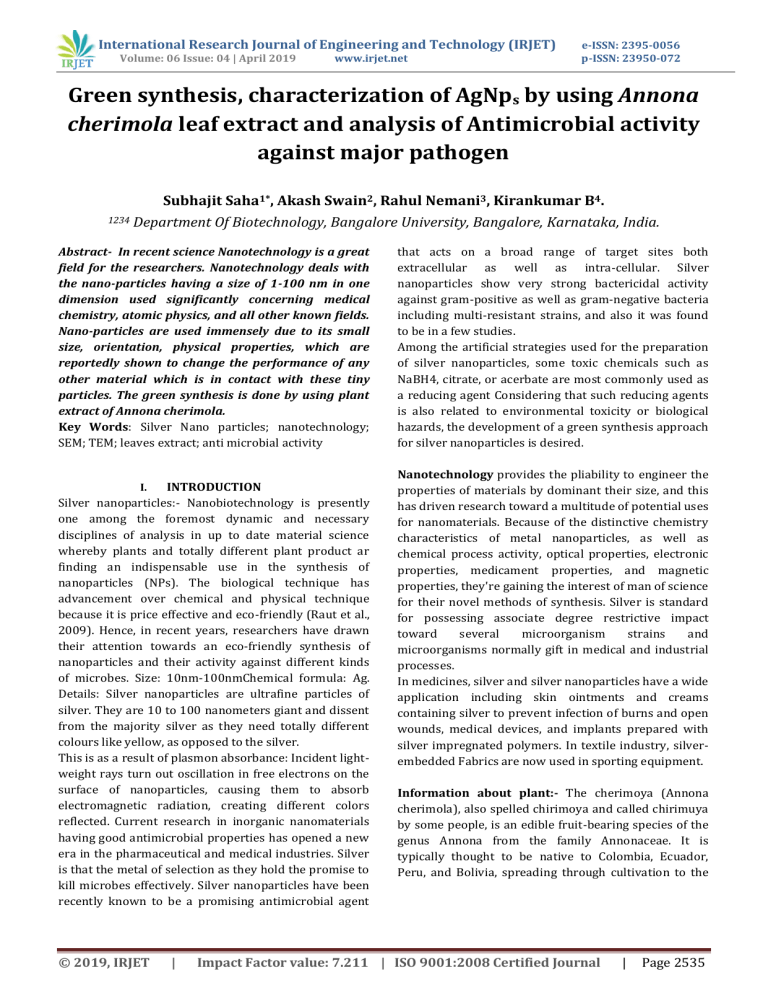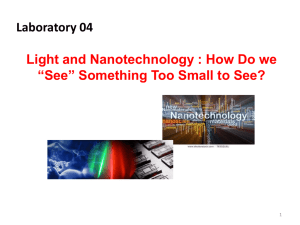IRJET-Green Synthesis, Characterization of Agnps by using Annona Cherimola Leaf Extract and Analysis of Antimicrobial Activity Against Major Pathogen

International Research Journal of Engineering and Technology (IRJET) e-ISSN: 2395-0056
Volume: 06 Issue: 04 | April 2019 www.irjet.net p-ISSN: 23950-072
Green synthesis, characterization of AgNp
s
by using Annona cherimola leaf extract and analysis of Antimicrobial activity against major pathogen
Subhajit Saha
1*
, Akash Swain
2
, Rahul Nemani
3
, Kirankumar B
4
.
1234
Department Of Biotechnology, Bangalore University, Bangalore, Karnataka, India.
Abstract- In recent science Nanotechnology is a great field for the researchers. Nanotechnology deals with the nano-particles having a size of 1-100 nm in one dimension used significantly concerning medical chemistry, atomic physics, and all other known fields.
Nano-particles are used immensely due to its small size, orientation, physical properties, which are reportedly shown to change the performance of any other material which is in contact with these tiny particles. The green synthesis is done by using plant extract of Annona cherimola.
Key Words : Silver Nano particles; nanotechnology;
SEM; TEM; leaves extract; anti microbial activity
I.
INTRODUCTION
Silver nanoparticles:- Nanobiotechnology is presently one among the foremost dynamic and necessary disciplines of analysis in up to date material science whereby plants and totally different plant product ar finding an indispensable use in the synthesis of nanoparticles (NPs). The biological technique has advancement over chemical and physical technique because it is price effective and eco-friendly (Raut et al.,
2009). Hence, in recent years, researchers have drawn their attention towards an eco-friendly synthesis of nanoparticles and their activity against different kinds of microbes. Size: 10nm-100nmChemical formula: Ag.
Details: Silver nanoparticles are ultrafine particles of silver. They are 10 to 100 nanometers giant and dissent from the majority silver as they need totally different colours like yellow, as opposed to the silver.
This is as a result of plasmon absorbance: Incident lightweight rays turn out oscillation in free electrons on the surface of nanoparticles, causing them to absorb electromagnetic radiation, creating different colors reflected. Current research in inorganic nanomaterials having good antimicrobial properties has opened a new era in the pharmaceutical and medical industries. Silver is that the metal of selection as they hold the promise to kill microbes effectively. Silver nanoparticles have been recently known to be a promising antimicrobial agent that acts on a broad range of target sites both extracellular as well as intra-cellular. Silver nanoparticles show very strong bactericidal activity against gram-positive as well as gram-negative bacteria including multi-resistant strains, and also it was found to be in a few studies.
Among the artificial strategies used for the preparation of silver nanoparticles, some toxic chemicals such as
NaBH4, citrate, or acerbate are most commonly used as a reducing agent Considering that such reducing agents is also related to environmental toxicity or biological hazards, the development of a green synthesis approach for silver nanoparticles is desired.
Nanotechnology provides the pliability to engineer the properties of materials by dominant their size, and this has driven research toward a multitude of potential uses for nanomaterials. Because of the distinctive chemistry characteristics of metal nanoparticles, as well as chemical process activity, optical properties, electronic properties, medicament properties, and magnetic properties, they're gaining the interest of man of science for their novel methods of synthesis. Silver is standard for possessing associate degree restrictive impact toward several microorganism strains and microorganisms normally gift in medical and industrial processes.
In medicines, silver and silver nanoparticles have a wide application including skin ointments and creams containing silver to prevent infection of burns and open wounds, medical devices, and implants prepared with silver impregnated polymers. In textile industry, silverembedded Fabrics are now used in sporting equipment.
Information about plant:- The cherimoya (Annona cherimola), also spelled chirimoya and called chirimuya by some people, is an edible fruit-bearing species of the genus Annona from the family Annonaceae. It is typically thought to be native to Colombia, Ecuador,
Peru, and Bolivia, spreading through cultivation to the
© 2019, IRJET | Impact Factor value: 7.211 | ISO 9001:2008 Certified Journal | Page 2535
International Research Journal of Engineering and Technology (IRJET) e-ISSN: 2395-0056
Volume: 06 Issue: 04 | April 2019 www.irjet.net p-ISSN: 23950-072
Andes and Central America. Cherimoya is grownup in tropical regions throughout the globe.
The species reproduces by seeds but can be propagated by grafting. The genus Annona, commonly known as the custard-apple genus, consists of some 125 species with some species widely cultivated for their edible fruits and often becoming naturalized beyond their native range of tropical America and Africa. The species A. cherimola is named ‘chirimuya’ or a variation thereof in several languages including Spanish and derives from the Incan
(Quechua) name for the species meaning ‘cold seeds’, referring to the high altitudes in which the plant grows and seeds germinate
II . LITERATURE REVIEW
A.sasikala et al [1], Biological synthesis of silver nano particles from Cocholos permum religiosum and their anti bacterial efficiency.
presented that microbial enzymes are in great demand owing to their importance in several industries such as brewing, baking, leather, laundry detergent, dairy, starch processing and textiles besides pharmaceuticals. About 80% of the enzymes produced through fermentation and sold in the industrial scale are hydrolytic enzyme .
Aniruddha Mukhopahayay et al [2], proposed that leaf extract mediated green synthesis of silvernanoparticles from widely available indian plants: synthesis, characterization, antimicrobial property and toxicity analysis.
Daizy Philip et al [3] , explain about extracellular biosynthesis of gold and silver nano particles using
Krishna tulsi(Ocimum sanctum) leaf.
III.
MATERIALS AND METHOD
Materials:-
1. Plant material: Fresh Cherimoya Leaves.
2. Chemicals: silver nitrate [AgNo
3
], distilled water ethanol.
3. Glass wares: Chopping Knife, Conical Flask and Petri- plates, Beaker, Culture Tube, Spreader and Gel Puncher.
4. Instruments: Autoclaves, Centrifuge,
Spectrophotometer, Hot Air Oven, Hot Plate,
Transmission Electron Microscope, Weighing Machine.
5. Cultures: Pure culture of gram positive and gram negative bacteria
Methods:-
1. Collection of leaves-
A major source of plant materials is forest and also occurs from rural areas, agriculture land. First, collect the plant and separate the good and healthy leaves.
They are washed with several times with tap water and washed several times with distilled water after they dried at room temperature 37°c for removal of moisture.
Fig1: Collection of ‘Chirimuya’ leaves
2. Preparation of leaf Extract-
10-15gm of leaves were weighed and sliced into small pieces, and then 100-200ml of double water was superimposed and so cooked. After boiling the solution it is cooled. After cooling the extract was filtered with
Whatmann no.1 filter paper. The dark yellow colored extract was obtained stored, which were used as reducing agent and stabilizer. Then store at 40c for further usage.
Fig2: Leaf extract of ‘Cherimoya’ leaves
3. Preparation of AgNO
3
Solution-
Required molar AgNO
3
solution was prepared by an accurate amount of silver nitrate was dissolved in the required volume of water .generally for the preparation of silver nanoparticles we use 1mM silver nitrate solution. The solution was stored at the dark color bottle for preventing to auto-oxidation. [0.0168g AgNo
3
/100ml D.W]
© 2019, IRJET | Impact Factor value: 7.211 | ISO 9001:2008 Certified Journal | Page 2536
International Research Journal of Engineering and Technology (IRJET) e-ISSN: 2395-0056
Volume: 06 Issue: 04 | April 2019 www.irjet.net p-ISSN: 23950-072
Fig2: Prepared AgNo
3
Solution
4. Green Synthesis of leaving Silver Nanoparticles-
Generally, 80 or 90 ml of AgNO3 was added to 20 or 10 ml of leaf extract and follow some physical techniques like heat, stirring then the solution was incubated some time. The color change was observed, it is indicated by the formation of silver nanoparticles, which was confirmed by UV-visible spectro-photometer. The formed silver nano-particles were centrifuge separated and dried.
Fig2: Synthesis of AgNp s
IV.
RESULT AND DISCUSSION
1. Characterization:- a) U.V-Visible Spectral Study:-
Formation and stability of AgNP, s sterile distilled water is confirmed using UV-Visible spectrophotometer in a range of wavelength from 400 to 800 nm. The production of silver nanoparticles by the reduction of silver ions due to the addition of leaves extract. The band observed in spectrum, confirmed by silver nanoparticles. Various plants leave extracts were giving peaks at different wave length. Most of the plants give band at 400-490nm region. (S. Kaviya 2011).Different plant leaves show following absorption values.
Fig2: Normal range of UV for silver nano particles will be between 200 to 800 nm.
Annona cherimola leaf plant extract Uv ranges between
350-460nm that is within the normal range. So by this
UV results, it is confirmed that Annona cherimola leaf extract can be observed. b) SEM [Scanning Electron Microscopy] Analysis:-
SEM analysis present uniformly distributed silver nano particles on the surfaces of the cells. The suspended silver nano particles in sterile distilled water were used for scan electron microscope analysis by fabricating a drop of suspension onto clean electric stubs and allowing water to completely evaporate. SEM analysis gives the size of silver nanoparticles. Majority cases a large size silver nanoparticle was observed due to an agglomeration of smaller ones.
Fig2: SEM analysis- size 10um and 5um zoom; Voltage-
20kv c) TEM [Transmission Electron Microscopy] Analysis:-
TEM analysis gives information about the morphology of the silver nano particles .generally silver nano particles are spherical or crystal structures. Tem also give the average mean size of silver nano particles. TEM measurements were performed on the JEOL model JEM
© 2019, IRJET | Impact Factor value: 7.211 | ISO 9001:2008 Certified Journal | Page 2537
International Research Journal of Engineering and Technology (IRJET) e-ISSN: 2395-0056
Volume: 06 Issue: 04 | April 2019 www.irjet.net p-ISSN: 23950-072
2100 instrument operated at an accelerating voltage at
120 kV.
Fig2: TEM analysis results of Annona cherimola AgNps.
Particles size ranges from 30nm-35nm.
Test details:-
Test equipment- Transmission Electron Microscopy
Maker- FEI
Model- G2 Biotwin 120 KV
Testing Laboratory- Election Microscopy Facility,
Division of Biological Science, IISC. d) XRD Analysis:-
Analysis through X-ray diffraction was carried out to confirm the crystalline nature of the particles, and the
XRD pattern showed numbers of Bragg’s reflections that may be indexed on the basis of the face-centered cubic structure of silver. The XRD coming from leaf was compare with standard spectrum. The peaks at 2θ v values corresponding to the (111), (200), (220), (311) respectively Bragg reflect-ions of silver. The X-ray diffraction results clearly, show that the silver nanoparticles formed by the reduction of Ag+ ions by the leaves extract are crystalline in nature. The average particle size of silver nanoparticles synthesized by the present green the method can be calculated using
Debye-Scherer equation.
Fig2: XRD Analysis results of Annona cherimola AgNps e) Anti Microbial Activity Analysis:-
The anti-microbial activity of biosynthesized silver nano-particles was tested by Disc diffusion method. The silver nanoparticles formed from different medical plants leaves extracts to show different biological activity. Antibacterial activity of the synthesized Ag NPs was studied by the standard well method. The overnight grown bacterial suspensions of –
1 .Escherichia coli , (standard)
2. Xanthomonas sp . (lemon plant pathogen)
3. Pseudomonas syringae , (tomato plant pathogen)
4 . Bacillus subtilis (plant endophytic bacteria)
5. Staphylococcus aureus
Were standardized using gel puncher. 5 mm diameter well made by gel puncher. The dilutions of biosynthesized Ag NPs varying from 5 mg, 10 mg and 15 mg/ml were prepared with two-fold symmetry. 20 ml of molten sterilized nutrient agar solution was poured into each Petri plates and seven organisms were grown in them. The tested organisms were inoculated in four well(5 mm diameter), which is contains in different dilutions of Ag NPs (5 mg, 10 mg and 15 mg/ml) solutions, Each Petri plate was loaded with 1 or 2 well.
The plates containing the bacteria and Ag NPs were incubated at 37°C, and then examined for confirmation appears as a clear area around the well. The diameter of such zones of inhibition was measured employing a meter ruler, and also the mean for every organism was recorded and expressed in millimeters.
Fig2: The anti-bacterial activity of Ag NPs in
(a) Xanthomonas sp . (lemon plant pathogen),
(b) Staphylococcus aureus, (c) Escherichia coli ,
(standard), (d) Positive control, (e) Bacillus subtilis ), (f)
Pseudomonas syringae ,(tomato plant pathogen) at various concentrations.
© 2019, IRJET | Impact Factor value: 7.211 | ISO 9001:2008 Certified Journal | Page 2538
International Research Journal of Engineering and Technology (IRJET) e-ISSN: 2395-0056
Volume: 06 Issue: 04 | April 2019 www.irjet.net p-ISSN: 23950-072
Fig2 : Anti Microbial Activity results of Annona cherimola silver nanoparticles at various concentrations.
V.
CONCLUSION
Green synthesis silver nanoparticles (AgNPs) were successfully obtained from bioreduction of silver nitrate solutions using Annona cherimola. AgNPs have been appropriately characterized using UV-vis spectroscopy,
SEM, TEM analysis. Silver nanoparticles also aided in plant germination and growth by sequestering nutrients for them and could be implemented for agricultural purposes. Hence, thanks to their benign and stable nature and antimicrobial property, these AgNPs may be well utilized in industrial and remedial purposes.
However, plant uptake and utilization of AgNPs need additional elaborate analysis on several problems like uptake potential of varied species, the process of uptake and translocation and the activities of the AgNPs at the cellular or molecular levels.
Biosynthesis of nanoparticles may be a reasonably bottom-up approach wherever the most reaction occurring is reduction/oxidation. The need for the biosynthesis of nanoparticles rose as the physical and chemical processes were costly. Often, chemical synthesis methodology results in the presence of a number of the toxicant chemical absorbed on the surface which will have associate degree adverse result within the medical applications .. in the search of cheaper pathways for nanoparticles synthesis, scientist used microbial enzymes and plant extracts
(phytochemicals). With their antioxidant or reducing properties, they are usually responsible for the reduction of metal compounds into their respective nanoparticles. Green synthesis provides advancement over chemical and physical methodology as a result of it's economical, environment-friendly, simply scaled up for giant scale synthesis and during this technique, there's no would like to use air mass, energy, temperature, and toxicant chemicals.
VI.
REFERENCES
[1] A.sasikala
(1964). Microbial enzyme production.
In: Global impacts of applied microbiology, J. Appl microbial. Biotechnol. Starr, M.P. (Ed). John Wiley and sons Ltd; 12: 113.
[2] Anupam singh, Subhangi Mittal, Rohit Shrivastav,
Sahab dass, Digest journals of nano materials and bio structures,vol.7, No3, September-2012, p.1157-1163.Bio synthesis of silver nano particles using Ricinus communis L.leaf extract and its anti bacterial activites.
[3] Daizy Philip, C.Unni, Physica E 43 (2011) 1318–
1322, Extracellular biosynthesis of gold and silver nano particles using Krishna tulsi(Ocimum sanctum) leaf.
[4] Priya Banerjee, Mantosh Satapathy, Aniruddha
Mukhopahayay and Papita Banerjee.2014,4.Leaf
Extract Mediated Green Synthesis Of
Silvernanoparticles From Widely Available Indian
Plants: Synthesis, Characterizat-ion, Antimicrobial
Property And Toxicity Analysis.
1:3http://Www.Bioresourcesbioprocessing.Com/
Content/1/1/3.
[5] Raju Viveka, Ramar Thangama,b, Krishnasamy
Muthuchelianc, Palani Gunasekaranb,
Krishnasamy Kaverib, Soundarapandian
Kannana,Process Biochemistry,Green biosynthesis of silver nanoparti-cles from Annona squamosa leaf extract and it’s in vitro cytotoxic effect on
MCF-7 cells.
[6] Shivakumar Sing And Vidyasagar. 2014. Green
Synthesis, Characterization And Antimicrobial
Activity Of Silver Nanoparticles By Using Sterculia
Foetida. International Journal Of Green Chemistry
And Bioprocess Issn 2277-7199.
[7] Sangeetha et al. world journals of pharmaceutical research, ISSN: 2277-7105, volume-3, issue 7,
2014, 1055- 1066.Amylose inhibitory of silver nano particles bio synthesized using breynia retusa leaf extracts.
[8] Chawla AS, Sharma AK, Handa SS, Dhar KL (1992)
Chemical investigation and anti-inflammatory activity of Vitex negundo seeds. J Nat Prod 55:
163-167.
[9] Rimando AM, Inoshiri S, Otsuka H, Kohda H,
Yamasaki K, Padolina WG, Torres L, Quintana EG,
Cantoria MC (1987) Screening for mast cell histamine release inhibitory activity of Philippine
© 2019, IRJET | Impact Factor value: 7.211 | ISO 9001:2008 Certified Journal | Page 2539
International Research Journal of Engineering and Technology (IRJET) e-ISSN: 2395-0056
Volume: 06 Issue: 04 | April 2019 www.irjet.net p-ISSN: 23950-072 medicinal plants active constituent of Ehretia microphylla. Shoyakugaku Zasshi 41: 242-247.
[10] Mukherjee KS, Badruddoza S (1981) Chemical constituents of Dillenia indicaLinn. and Vitex negundo Linn. J Indian Chem Soc 58 97-98.
[11] Kalpana D, Soo Lee Y (2013) Synthesis and characterization of bactericidal silver nanoparticles using cultural filtrate of simulated microgravity grown Klebsiella pneumoniae.
Enzyme and Microbial Technology 52: 151-156.
[12] Raja K, Saravanakumar A, Vijayakumar R (2012)
Efficient synthesis of silver nanoparticles from
Prosopis juliflora leaf extract and its antimicrobial activity using sewage. Spectrochim Acta Part A 97:
490-494.
[13] Kumar R, Mohana Roopan S, Prabhakarn A,
Khanna VG, Chakroborty S (2012) Agricultural waste Annona squamosa peel extract:
Biosynthesis of silver nanoparticles. Spectrochim
Acta Part A 90: 173-176.
[14] Jayaseelan C, Ramkumar R, Rahuman AA, Perumal
P (2013) Green synthesis of gold nanoparticles using seed aqueous extract of Abelmoschus esculentus and its antifungal activity. Ind Crops
Prod 45: 423-429.
[15] Magudapathy Z, Gangopadhyay P, Panigrahi BK,
Nair KGM, Dhara S (2001) Electrical transport studies of Ag nanoclusters embedded in glass matrix. Physica B: Cond Matt 299: 142-146.
[16] Zhang Y, Cheng X, Zhang Y, Xue X, Fu Y (2013)
Biosynthesis of silver nanoparticles at room temperature using aqueous aloe leaf extract and antibacterial activity.
© 2019, IRJET | Impact Factor value: 7.211 | ISO 9001:2008 Certified Journal | Page 2540






